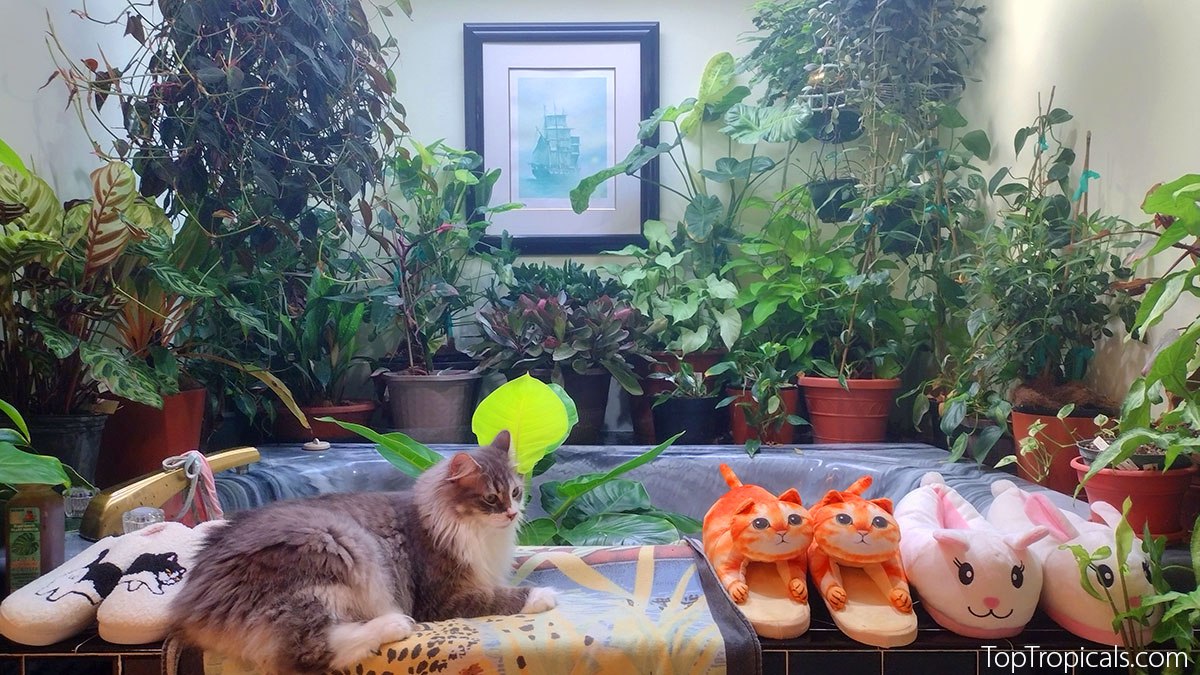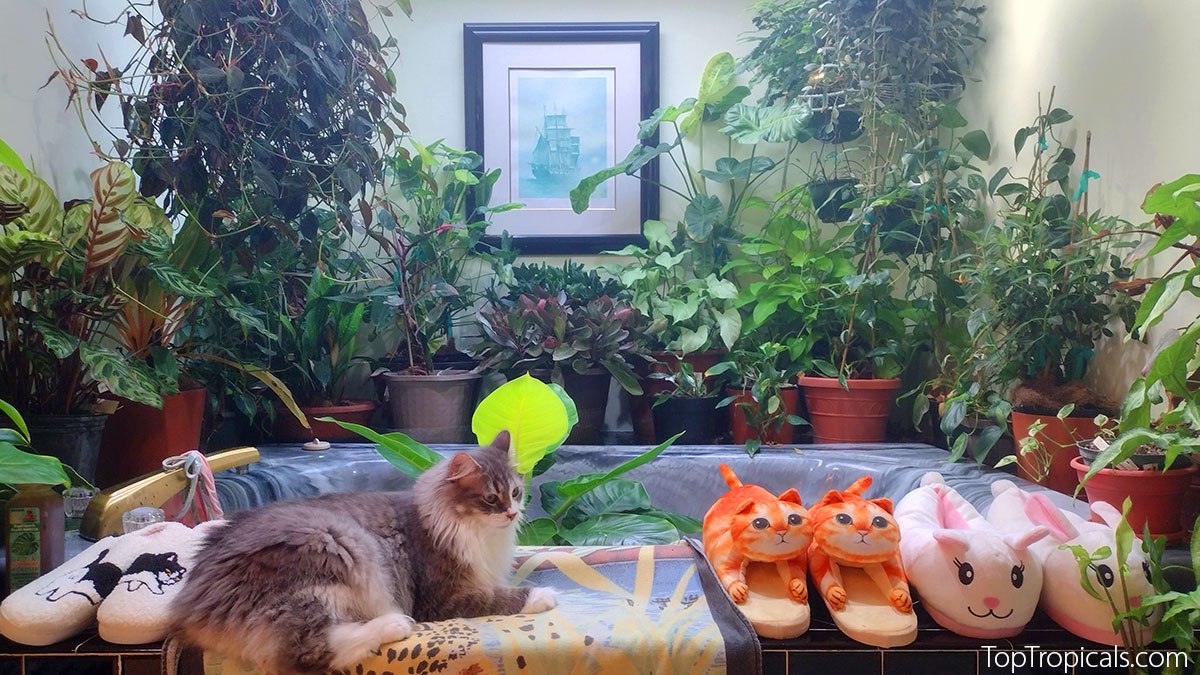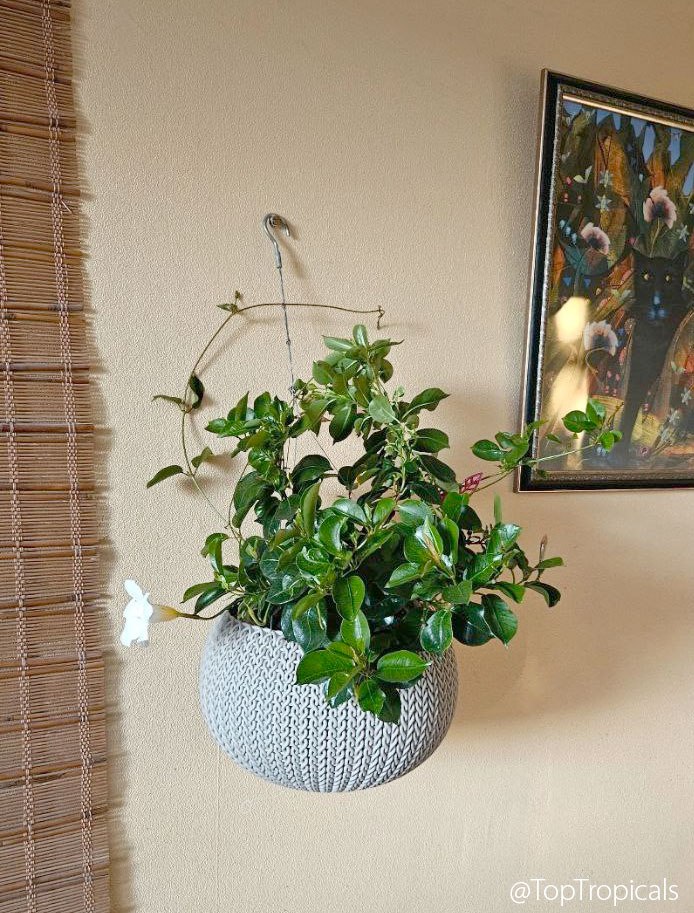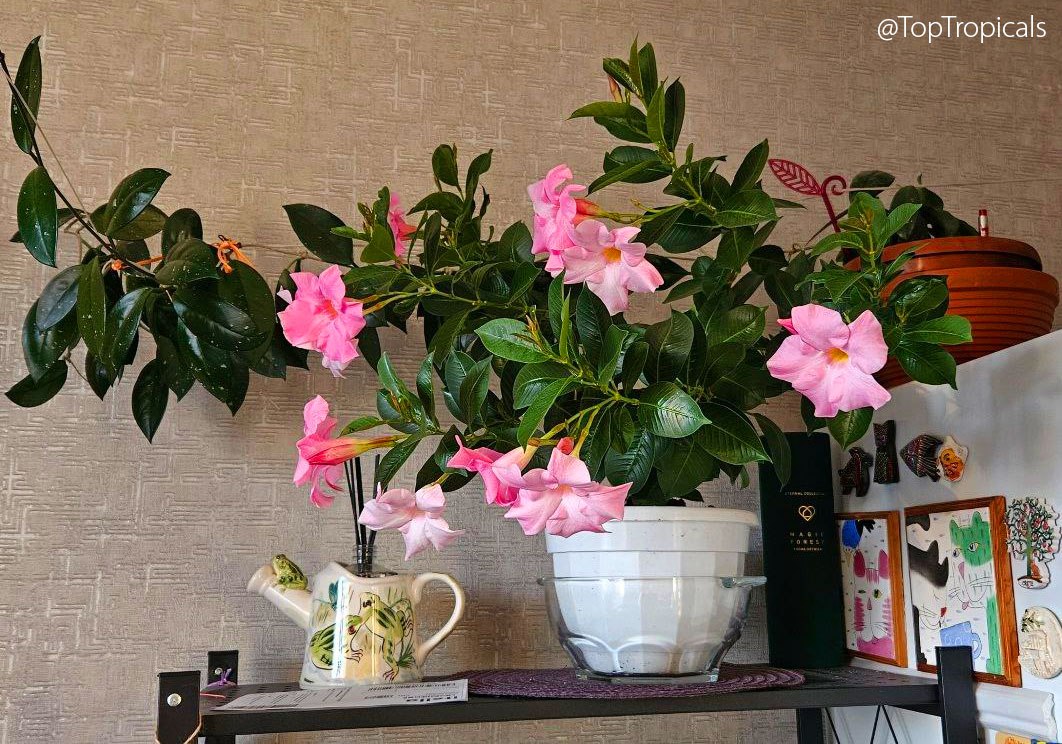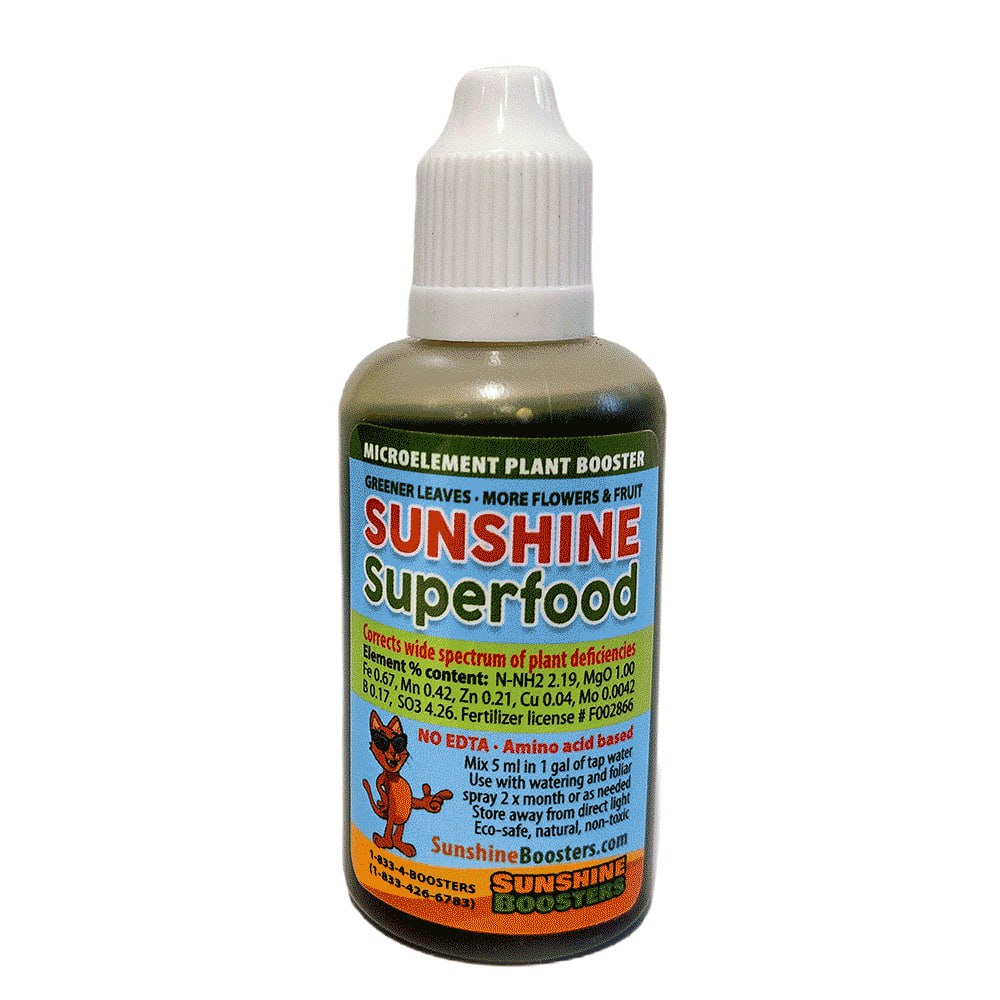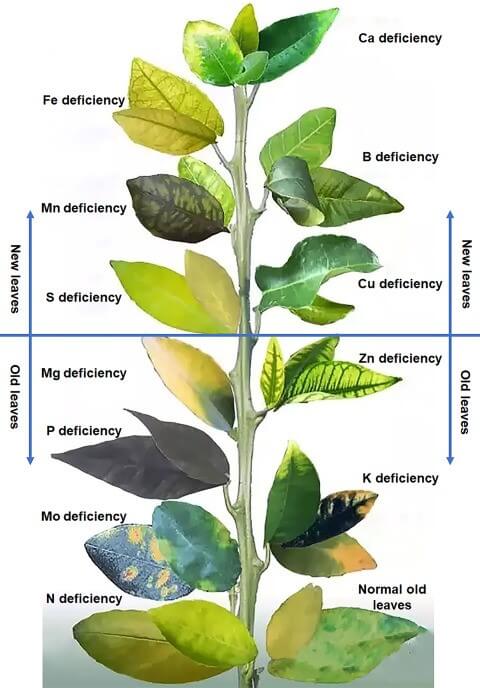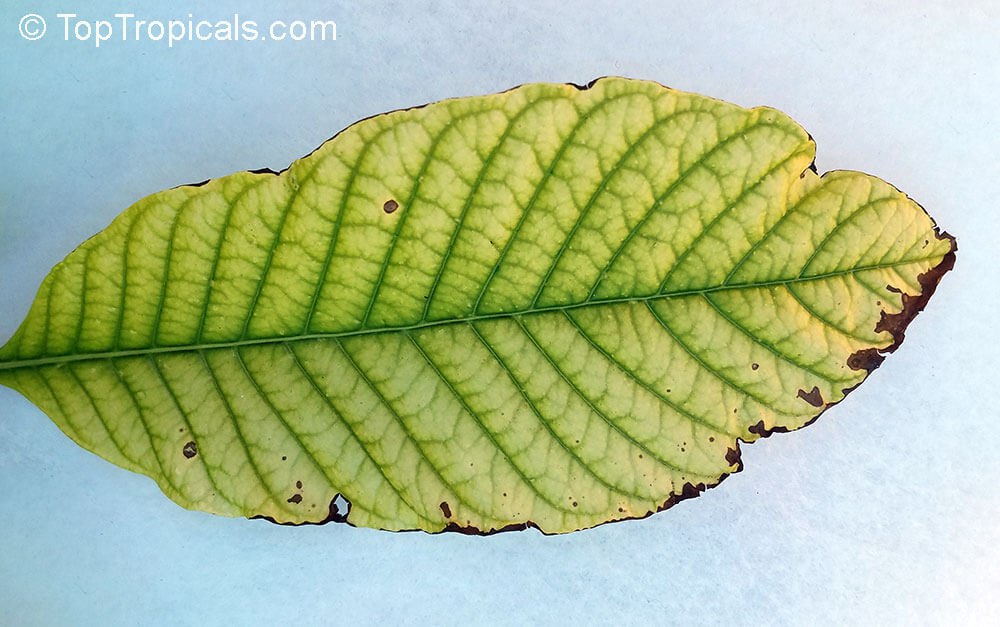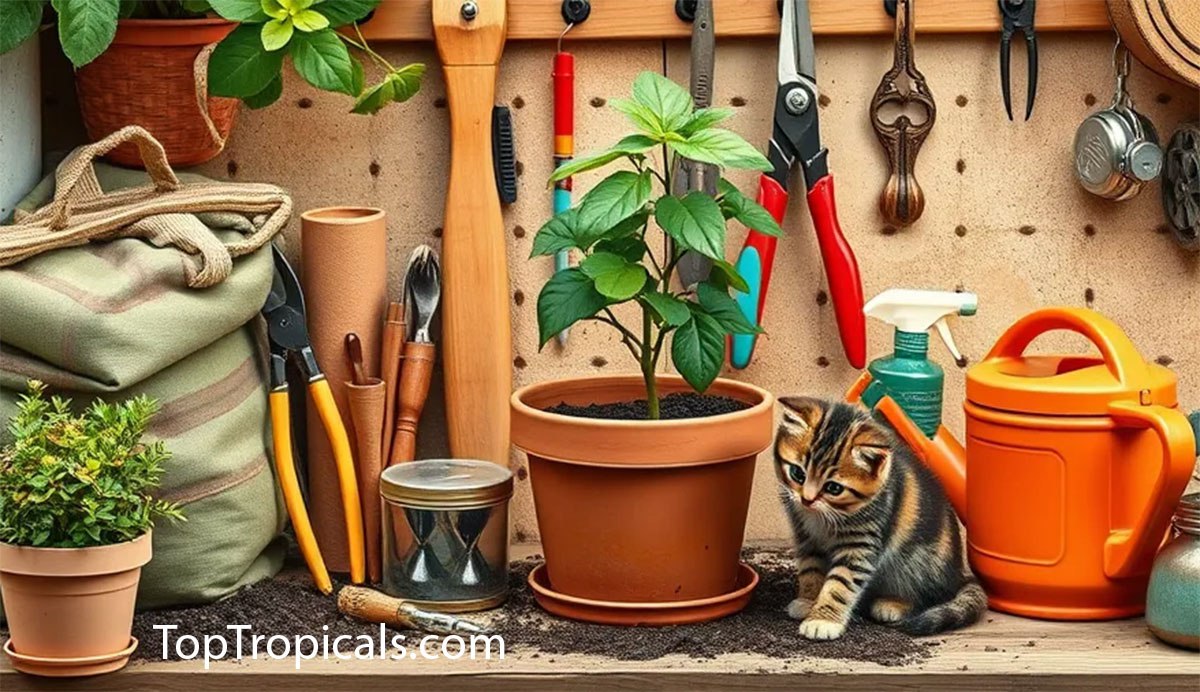Garden Blog - Top Tropicals
10 key tips for successful overwintering of tropical plants indoors
10 key tips for successful overwintering of tropical plants indoors
1. Maximize Light: The more light, the better. There's no such thing as too much indoor light. If windows aren't enough, use LED grow lights, which stay cool and won't dry the air. Rotate plants every few days to prevent uneven leaf loss.
2. Reduce Watering: Less light and cooler temperatures mean plants need less water. Allow the soil to dry between waterings, and avoid overwatering - combination of cold + wet is especially harmful.
3. Maintain Moderate Temperatures: Most tropicals are happy with daytime temperatures around 75F and nights at 50-60F. In sunrooms or greenhouses, some can handle 45F if watering is kept to a minimum.
4. Boost Humidity: Avoid placing plants near heaters or vents that dry the air. Misting daily helps, or place pots on trays filled with water and pebbles to raise humidity around them.
5. Monitor for Pests: Check leaves weekly to catch insect problems early, as pests can cause serious damage or even kill the plant indoors.
6. Fertilize Smart: Use ONLY liquid, amino-acid-based fertilizers like Sunshine Boosters throughout winter; they won't burn roots since their dosage adjusts with reduced watering. Avoid dry, granulated, and EDTA-based fertilizers during winter and dormancy.
7. Use Micro-Nutrients: Along with macro-elements (fertilizers), supplement with micro-elements like Sunshine Superfood and bio-stimulants such as Sunshine Epi to build strong plants with robust immune systems, better able to withstand unfavorable conditions and resist diseases.
8. Hold Off on Pruning: Leaf drop and leggy growth are normal responses to winter. Wait until spring to prune, when new growth starts, to encourage branching and healthy foliage.
9. Don't Repot Yet: During dormancy, roots slow their growth. Repotting too soon risks root rot. Wait until spring when new growth appears to transplant into a larger container. Typically, roots grow in proportion to the above-ground parts.
10. Let Them Rest: Winter is a natural resting period. Avoid forcing growth - your plants will reward your patience with vibrant leaves and flowers when spring returns.
🛒 Shop Indoor plants
#How_to
🔴 Join 👉 TopTropicals
1. Maximize Light: The more light, the better. There's no such thing as too much indoor light. If windows aren't enough, use LED grow lights, which stay cool and won't dry the air. Rotate plants every few days to prevent uneven leaf loss.
2. Reduce Watering: Less light and cooler temperatures mean plants need less water. Allow the soil to dry between waterings, and avoid overwatering - combination of cold + wet is especially harmful.
3. Maintain Moderate Temperatures: Most tropicals are happy with daytime temperatures around 75F and nights at 50-60F. In sunrooms or greenhouses, some can handle 45F if watering is kept to a minimum.
4. Boost Humidity: Avoid placing plants near heaters or vents that dry the air. Misting daily helps, or place pots on trays filled with water and pebbles to raise humidity around them.
5. Monitor for Pests: Check leaves weekly to catch insect problems early, as pests can cause serious damage or even kill the plant indoors.
6. Fertilize Smart: Use ONLY liquid, amino-acid-based fertilizers like Sunshine Boosters throughout winter; they won't burn roots since their dosage adjusts with reduced watering. Avoid dry, granulated, and EDTA-based fertilizers during winter and dormancy.
7. Use Micro-Nutrients: Along with macro-elements (fertilizers), supplement with micro-elements like Sunshine Superfood and bio-stimulants such as Sunshine Epi to build strong plants with robust immune systems, better able to withstand unfavorable conditions and resist diseases.
8. Hold Off on Pruning: Leaf drop and leggy growth are normal responses to winter. Wait until spring to prune, when new growth starts, to encourage branching and healthy foliage.
9. Don't Repot Yet: During dormancy, roots slow their growth. Repotting too soon risks root rot. Wait until spring when new growth appears to transplant into a larger container. Typically, roots grow in proportion to the above-ground parts.
10. Let Them Rest: Winter is a natural resting period. Avoid forcing growth - your plants will reward your patience with vibrant leaves and flowers when spring returns.
🛒 Shop Indoor plants
#How_to
🔴 Join 👉 TopTropicals
10 key tips for successful overwintering of tropical plants indoors
10 key tips for successful overwintering of tropical plants indoors
1. Maximize Light: The more light, the better. There's no such thing as too much indoor light. If windows aren't enough, use LED grow lights, which stay cool and won't dry the air. Rotate plants every few days to prevent uneven leaf loss.
2. Reduce Watering: Less light and cooler temperatures mean plants need less water. Allow the soil to dry between waterings, and avoid overwatering - combination of cold + wet is especially harmful.
3. Maintain Moderate Temperatures: Most tropicals are happy with daytime temperatures around 75F and nights at 50-60F. In sunrooms or greenhouses, some can handle 45F if watering is kept to a minimum.
4. Boost Humidity: Avoid placing plants near heaters or vents that dry the air. Misting daily helps, or place pots on trays filled with water and pebbles to raise humidity around them.
5. Monitor for Pests: Check leaves weekly to catch insect problems early, as pests can cause serious damage or even kill the plant indoors.
6. Fertilize Smart: Use ONLY liquid, amino-acid-based fertilizers like Sunshine Boosters throughout winter; they won't burn roots since their dosage adjusts with reduced watering. Avoid dry, granulated, and EDTA-based fertilizers during winter and dormancy.
7. Use Micro-Nutrients: Along with macro-elements (fertilizers), supplement with micro-elements like Sunshine Superfood and bio-stimulants such as Sunshine Epi to build strong plants with robust immune systems, better able to withstand unfavorable conditions and resist diseases.
8. Hold Off on Pruning: Leaf drop and leggy growth are normal responses to winter. Wait until spring to prune, when new growth starts, to encourage branching and healthy foliage.
9. Don't Repot Yet: During dormancy, roots slow their growth. Repotting too soon risks root rot. Wait until spring when new growth appears to transplant into a larger container. Typically, roots grow in proportion to the above-ground parts.
10. Let Them Rest: Winter is a natural resting period. Avoid forcing growth - your plants will reward your patience with vibrant leaves and flowers when spring returns.
🛒 Shop Indoor plants
#How_to
🔴 Join 👉 TopTropicals
1. Maximize Light: The more light, the better. There's no such thing as too much indoor light. If windows aren't enough, use LED grow lights, which stay cool and won't dry the air. Rotate plants every few days to prevent uneven leaf loss.
2. Reduce Watering: Less light and cooler temperatures mean plants need less water. Allow the soil to dry between waterings, and avoid overwatering - combination of cold + wet is especially harmful.
3. Maintain Moderate Temperatures: Most tropicals are happy with daytime temperatures around 75F and nights at 50-60F. In sunrooms or greenhouses, some can handle 45F if watering is kept to a minimum.
4. Boost Humidity: Avoid placing plants near heaters or vents that dry the air. Misting daily helps, or place pots on trays filled with water and pebbles to raise humidity around them.
5. Monitor for Pests: Check leaves weekly to catch insect problems early, as pests can cause serious damage or even kill the plant indoors.
6. Fertilize Smart: Use ONLY liquid, amino-acid-based fertilizers like Sunshine Boosters throughout winter; they won't burn roots since their dosage adjusts with reduced watering. Avoid dry, granulated, and EDTA-based fertilizers during winter and dormancy.
7. Use Micro-Nutrients: Along with macro-elements (fertilizers), supplement with micro-elements like Sunshine Superfood and bio-stimulants such as Sunshine Epi to build strong plants with robust immune systems, better able to withstand unfavorable conditions and resist diseases.
8. Hold Off on Pruning: Leaf drop and leggy growth are normal responses to winter. Wait until spring to prune, when new growth starts, to encourage branching and healthy foliage.
9. Don't Repot Yet: During dormancy, roots slow their growth. Repotting too soon risks root rot. Wait until spring when new growth appears to transplant into a larger container. Typically, roots grow in proportion to the above-ground parts.
10. Let Them Rest: Winter is a natural resting period. Avoid forcing growth - your plants will reward your patience with vibrant leaves and flowers when spring returns.
🛒 Shop Indoor plants
#How_to
🔴 Join 👉 TopTropicals
How to overwinter tropical plants indoors
❄️ How to overwinter tropical plants indoors
❓ I have two Mandevillas that thrived on my balcony all summer. Now that cold weather is approaching, I've moved them indoors to bright spots, but they're dropping and wilting leaves. How can I keep them healthy until spring? Should I fertilize them? Can Mandevillas grow indoors year-round?
✔️ First, keep in mind that the plants we call "indoor plants" or "house plants" are all tropical. However, not all tropical plants are suitable for indoor living. Some, especially shade-loving ones, thrive in indoor conditions, which is why we refer to them as "house plants" (philodendrons, monsteras, calatheas, peperomias, and many others, including some succulents). Others are less adaptable to the lower light and humidity typical of indoor spaces, but with a little extra care, you can overwinter them inside and move them back outdoors in spring. Mandevillas are no exception! Even tropical trees, including fruit trees, can tolerate a few months indoors if given the right conditions for semi-dormancy. Below are the 10 key tips for successfully overwintering tropical plants indoors.
Find out the secrets of overwintering in our next post ⬇️
🛒 Shop Indoor plants
#How_to
🔴 Join 👉 TopTropicals
❓ I have two Mandevillas that thrived on my balcony all summer. Now that cold weather is approaching, I've moved them indoors to bright spots, but they're dropping and wilting leaves. How can I keep them healthy until spring? Should I fertilize them? Can Mandevillas grow indoors year-round?
✔️ First, keep in mind that the plants we call "indoor plants" or "house plants" are all tropical. However, not all tropical plants are suitable for indoor living. Some, especially shade-loving ones, thrive in indoor conditions, which is why we refer to them as "house plants" (philodendrons, monsteras, calatheas, peperomias, and many others, including some succulents). Others are less adaptable to the lower light and humidity typical of indoor spaces, but with a little extra care, you can overwinter them inside and move them back outdoors in spring. Mandevillas are no exception! Even tropical trees, including fruit trees, can tolerate a few months indoors if given the right conditions for semi-dormancy. Below are the 10 key tips for successfully overwintering tropical plants indoors.
Find out the secrets of overwintering in our next post ⬇️
🛒 Shop Indoor plants
#How_to
🔴 Join 👉 TopTropicals
How to overwinter tropical plants indoors
❄️ How to overwinter tropical plants indoors
❓ I have two Mandevillas that thrived on my balcony all summer. Now that cold weather is approaching, I've moved them indoors to bright spots, but they're dropping and wilting leaves. How can I keep them healthy until spring? Should I fertilize them? Can Mandevillas grow indoors year-round?
✔️ First, keep in mind that the plants we call "indoor plants" or "house plants" are all tropical. However, not all tropical plants are suitable for indoor living. Some, especially shade-loving ones, thrive in indoor conditions, which is why we refer to them as "house plants" (philodendrons, monsteras, calatheas, peperomias, and many others, including some succulents). Others are less adaptable to the lower light and humidity typical of indoor spaces, but with a little extra care, you can overwinter them inside and move them back outdoors in spring. Mandevillas are no exception! Even tropical trees, including fruit trees, can tolerate a few months indoors if given the right conditions for semi-dormancy. Below are the 10 key tips for successfully overwintering tropical plants indoors.
Find out the secrets of overwintering in our next post ⬇️
🛒 Shop Indoor plants
#How_to
🔴 Join 👉 TopTropicals
❓ I have two Mandevillas that thrived on my balcony all summer. Now that cold weather is approaching, I've moved them indoors to bright spots, but they're dropping and wilting leaves. How can I keep them healthy until spring? Should I fertilize them? Can Mandevillas grow indoors year-round?
✔️ First, keep in mind that the plants we call "indoor plants" or "house plants" are all tropical. However, not all tropical plants are suitable for indoor living. Some, especially shade-loving ones, thrive in indoor conditions, which is why we refer to them as "house plants" (philodendrons, monsteras, calatheas, peperomias, and many others, including some succulents). Others are less adaptable to the lower light and humidity typical of indoor spaces, but with a little extra care, you can overwinter them inside and move them back outdoors in spring. Mandevillas are no exception! Even tropical trees, including fruit trees, can tolerate a few months indoors if given the right conditions for semi-dormancy. Below are the 10 key tips for successfully overwintering tropical plants indoors.
Find out the secrets of overwintering in our next post ⬇️
🛒 Shop Indoor plants
#How_to
🔴 Join 👉 TopTropicals
How to overwinter tropical plants indoors
❄️ How to overwinter tropical plants indoors
❓ I have two Mandevillas that thrived on my balcony all summer. Now that cold weather is approaching, I've moved them indoors to bright spots, but they're dropping and wilting leaves. How can I keep them healthy until spring? Should I fertilize them? Can Mandevillas grow indoors year-round?
✔️ First, keep in mind that the plants we call "indoor plants" or "house plants" are all tropical. However, not all tropical plants are suitable for indoor living. Some, especially shade-loving ones, thrive in indoor conditions, which is why we refer to them as "house plants" (philodendrons, monsteras, calatheas, peperomias, and many others, including some succulents). Others are less adaptable to the lower light and humidity typical of indoor spaces, but with a little extra care, you can overwinter them inside and move them back outdoors in spring. Mandevillas are no exception! Even tropical trees, including fruit trees, can tolerate a few months indoors if given the right conditions for semi-dormancy. Below are the 10 key tips for successfully overwintering tropical plants indoors.
Find out the secrets of overwintering in our next post ⬇️
🛒 Shop Indoor plants
#How_to
🔴 Join 👉 TopTropicals
❓ I have two Mandevillas that thrived on my balcony all summer. Now that cold weather is approaching, I've moved them indoors to bright spots, but they're dropping and wilting leaves. How can I keep them healthy until spring? Should I fertilize them? Can Mandevillas grow indoors year-round?
✔️ First, keep in mind that the plants we call "indoor plants" or "house plants" are all tropical. However, not all tropical plants are suitable for indoor living. Some, especially shade-loving ones, thrive in indoor conditions, which is why we refer to them as "house plants" (philodendrons, monsteras, calatheas, peperomias, and many others, including some succulents). Others are less adaptable to the lower light and humidity typical of indoor spaces, but with a little extra care, you can overwinter them inside and move them back outdoors in spring. Mandevillas are no exception! Even tropical trees, including fruit trees, can tolerate a few months indoors if given the right conditions for semi-dormancy. Below are the 10 key tips for successfully overwintering tropical plants indoors.
Find out the secrets of overwintering in our next post ⬇️
🛒 Shop Indoor plants
#How_to
🔴 Join 👉 TopTropicals
How to make your Hibiscus plants thrive and bloom
🌷 How to make your Hibiscus plants thrive and bloom
"If your plant isn't flowering, feed it." - Winn Soldani (Fancy Hibiscus)
💬 Among gardeners, Hibiscus plants have a reputation to have couple maintenance issues:
1. they can get bugsy (because they must be so tasty!)
2. they can get leggy, especially fancy grafted cultivars, and after a while they don't look as perfect as when they came from a nursery.
‼️ Tips for healthy and pretty hibiscus plants (can be applied to other flowering shrubs)
⚠️ Keys to balanced plant food and bloom booster
🌞 If you do this right, the result will be:
😎 We suggest Sunshine Boosters Megaflor - scientifically balanced liquid fertilizer that is amino acid based = natural and organic, can be used for both flowers and edibles, and what's most important - year around. It is safe to use virtually with every watering, all year around!
🔥 This is all you need for healthy plants and lots of flowers!
🛒 Get Sunshine Boosters Megaflor
#How_to #Fertilizers
🔴 Join 👉 TopTropicals
"If your plant isn't flowering, feed it." - Winn Soldani (Fancy Hibiscus)
💬 Among gardeners, Hibiscus plants have a reputation to have couple maintenance issues:
1. they can get bugsy (because they must be so tasty!)
2. they can get leggy, especially fancy grafted cultivars, and after a while they don't look as perfect as when they came from a nursery.
‼️ Tips for healthy and pretty hibiscus plants (can be applied to other flowering shrubs)
- 🟡Full sun. Essential for profuse flowering and keeps away diseases.
- 🟡Pruning. Keep it pruned and it will get bushy and produce more blooms.
- 🟡Well-drained soil. Hibiscus likes regular watering but hates wet feet.
- 🟡Nutrition program. Hibiscus plants are heavy feeders. But keep in mind that if you just keep pushing granulated plant food, you can over-fertilize the plant. Excessive salts will accumulate in soil and you will end up with a sickly looking plant.
⚠️ Keys to balanced plant food and bloom booster
- 💋Use liquid fertilizer, preferably amino acid based, it won't create nutrients lock up
- 💋Fertilize on regular basis, it's better dilute concentration and add food with every watering
- 💋Always add micro-elements - they are essential for plant health
🌞 If you do this right, the result will be:
- ⏺healthy, green plants, like they just came from a nursery
- ⏺reliable blooming circle
- ⏺better cold tolerance and disease resistance. Remember that a strong plant will be less ⏺stressed and less "bugged" by bugs!
😎 We suggest Sunshine Boosters Megaflor - scientifically balanced liquid fertilizer that is amino acid based = natural and organic, can be used for both flowers and edibles, and what's most important - year around. It is safe to use virtually with every watering, all year around!
🔥 This is all you need for healthy plants and lots of flowers!
🛒 Get Sunshine Boosters Megaflor
#How_to #Fertilizers
🔴 Join 👉 TopTropicals
Why my plant turned yellow? And why plants need Micronutrients? The answer is:
🍴 Why my plant turned yellow? And why plants need Micronutrients? The answer is: they need Superfood!
Why use Sunshine Superfood for micronutrients?
👍 Even if your soil is lacking in certain micronutrients, Sunshine Superfood ensures your plants get exactly what they need.
📚 Learn in details:
Micronutrients Delivery Systems
Element Deficiencies in Your Garden
🛒 Shop Sunshine Boosters
#Fertilizers #How_to
🔴 Join 👉 TopTropicals
Nothing is more disappointing than when your plant’s bright green leaves begin to turn yellow. Too often gardeners blame pests for these issues, but at the root of the problem is almost always a nutrient deficiency.
Plants need both macronutrients and micronutrients.
Why are micronutrients important?
Macronutrients (nitrogen, phosphorus, and potassium) help plants grow big and strong.
Micronutrients (like iron, zinc, copper, and manganese) are just like vitamins, needed in small amounts but are just as important for plant health.
- 📌 They help plants with vital processes like making food (photosynthesis) and building strong roots.
- 📌 Without enough micronutrients, plants can look weak, turn yellow, or grow poorly.
Why use Sunshine Superfood for micronutrients?
📌 Effective and fast: plants get the right amount of micronutrients quickly and efficiently.- 📌 Balanced formula: your plants get everything they need in the right proportions.
- 📌 Sunshine Superfood is the ultimate micro-element supplement that can fix all deficiencies.
- 📌 Easy to apply - just mix with water and feed your plants.
- 📌 The quick absorption helps prevent nutrient deficiencies.
👍 Even if your soil is lacking in certain micronutrients, Sunshine Superfood ensures your plants get exactly what they need.
📚 Learn in details:
Micronutrients Delivery Systems
Element Deficiencies in Your Garden
🛒 Shop Sunshine Boosters
#Fertilizers #How_to
🔴 Join 👉 TopTropicals
Why my plant turned yellow? And why plants need Micronutrients? The answer is:
🍴 Why my plant turned yellow? And why plants need Micronutrients? The answer is: they need Superfood!
Nothing is more disappointing than when your plant’s bright green leaves begin to turn yellow. Too often gardeners blame pests for these issues, but at the root of the problem is almost always a nutrient deficiency.
Plants need both macronutrients and micronutrients.
Macronutrients (nitrogen, phosphorus, and potassium) help plants grow big and strong.
Micronutrients (like iron, zinc, copper, and manganese) are just like vitamins, needed in small amounts but are just as important for plant health.
Why are micronutrients important?
Why use Sunshine Superfood for micronutrients?
👍 Even if your soil is lacking in certain micronutrients, Sunshine Superfood ensures your plants get exactly what they need.
📚 Learn in details:
Micronutrients Delivery Systems
Element Deficiencies in Your Garden
🛒 Shop Sunshine Boosters
#Fertilizers #How_to
🔴 Join 👉 TopTropicals
Nothing is more disappointing than when your plant’s bright green leaves begin to turn yellow. Too often gardeners blame pests for these issues, but at the root of the problem is almost always a nutrient deficiency.
Plants need both macronutrients and micronutrients.
Macronutrients (nitrogen, phosphorus, and potassium) help plants grow big and strong.
Micronutrients (like iron, zinc, copper, and manganese) are just like vitamins, needed in small amounts but are just as important for plant health.
Why are micronutrients important?
📌 They help plants with vital processes like making food (photosynthesis) and building strong roots.- 📌 Without enough micronutrients, plants can look weak, turn yellow, or grow poorly.
Why use Sunshine Superfood for micronutrients?
📌 Effective and fast: plants get the right amount of micronutrients quickly and efficiently.- 📌 Balanced formula: your plants get everything they need in the right proportions.
- 📌 Sunshine Superfood is the ultimate micro-element supplement that can fix all deficiencies.
- 📌 Easy to apply - just mix with water and feed your plants.
- 📌 The quick absorption helps prevent nutrient deficiencies.
👍 Even if your soil is lacking in certain micronutrients, Sunshine Superfood ensures your plants get exactly what they need.
📚 Learn in details:
Micronutrients Delivery Systems
Element Deficiencies in Your Garden
🛒 Shop Sunshine Boosters
#Fertilizers #How_to
🔴 Join 👉 TopTropicals
How to Make Fresh Noni Juice
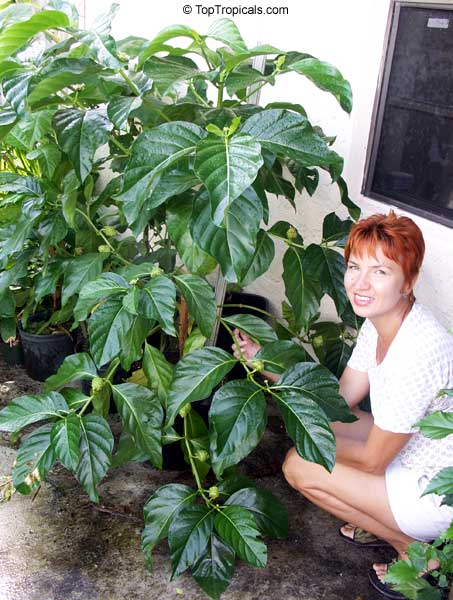
Moringa citrifolia - Noni
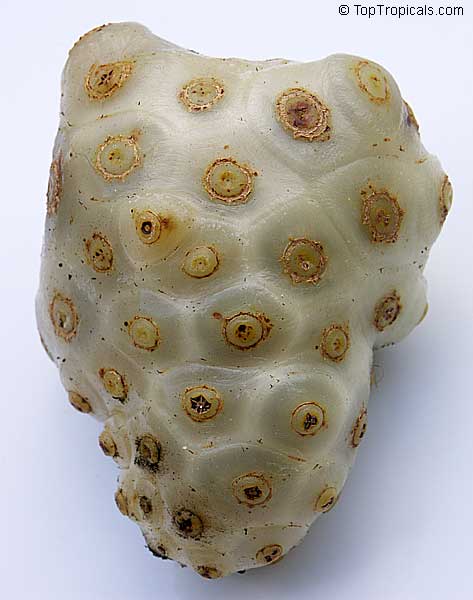
Moringa citrifolia - Noni fruit

Moringa citrifolia - Noni fruit

Noni Juice
🍾 How to Make Fresh Noni Juice. Step-by-Step Guide.
💊 Benefits of Fresh Noni Juice:
📚 Learn more from previous posts:
🛒 Plant your own Noni Tree
#Food_Forest #Remedies #How_to
🔴 Join 👉 TopTropicals
- Prepare the Noni: Wash the noni fruits thoroughly.
- Cut the Noni: Slice the fruits into small pieces for easier blending.
- Blend: Place the pieces in a blender or food processor. Blend until a smooth pulp forms.
- Strain (Optional): For smoother juice, strain the pulp through a cheesecloth or fine mesh to separate solids.
- Add flavor: you can add some Blueberry or Apple juice for improved flavor.
- Store: Pour the juice into clean, airtight glass jars or containers. Refrigerate for freshness.
💊 Benefits of Fresh Noni Juice:
- Supports joint health.
- Boosts physical endurance.
- Enhances immune activity and metabolism.
- Helps with weight management.
- Maintains bone health, especially in women.
- May support normal blood pressure.
- Promotes gum health and reduces protein glycation.
📚 Learn more from previous posts:
- · How to grow Noni tree for fruit
- · Why Noni is a superfood?
- · Morinda citrifolia - Noni: Life Sustaining Plant
🛒 Plant your own Noni Tree
#Food_Forest #Remedies #How_to
🔴 Join 👉 TopTropicals
10 common mistakes to avoid with mail order plants
⚠️ 10 common mistakes to avoid with mail order plants
Continued from previous post 👆
Always inspect new plants for pests. Shipping stress can lead to infestations, so a close check is vital.
🌷By avoiding these mistakes and following the planting instructions included with your order, you'll be on the right path to creating your tropical paradise. Take care of your new plant, and it will thrive, rewarding you with vibrant growth for years to come.
#How_to
🔴 Join 👉 TopTropicals
Continued from previous post 👆
⏺6. Placing the plant in the wrong environment
⏺7. Not trimming damaged branches.
⏺8. Expecting immediate growth
⏺9. Fertilizing too soon
⏺10. Not checking for pests
It's important to give your plant the right temperature, light, and humidity based on its natural habitat. We grow tropical plants. They won't survive in areas with freezing temperatures.
Transit can cause minor damage to leaves or branches. Trimming these parts can help the plant recover faster.
Plants need time to adjust after the trip. Give them a chance to settle for a few weeks before expecting new growth or blooms.
Do not fertilize your plant right after arrival. Let it get established first - usually a few weeks - before adding fertilizer to avoid stressing the plant.
Always inspect new plants for pests. Shipping stress can lead to infestations, so a close check is vital.
🌷By avoiding these mistakes and following the planting instructions included with your order, you'll be on the right path to creating your tropical paradise. Take care of your new plant, and it will thrive, rewarding you with vibrant growth for years to come.
#How_to
🔴 Join 👉 TopTropicals
